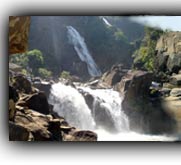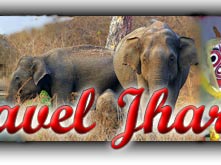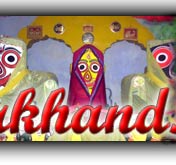 |
 |
 |
 |
 |
- Welcome
- Search TravelJharkhand.com
 Jharkhand has a population of 26.90 million, consisting of 13.86 million males and 13.04 million females. Like most of our states Jharkhand is also a melting pot where people from different parts of the country have come and settled down. But the original inhabitants are remarkably prominent. The population consists of 28% tribes, 12% Scheduled Castes and 60% others. The sex ratio is 941 females to 1000 males. There are 274 persons for each square kilometer of land. However, the population density varies considerably from as low as 148 per square kilometer in Gumla district to as high as 1167 per square kilometer in Dhanbad district. Around 10% of the population is Bengali speaking and 70% speak various dialect of Hindi.
Jharkhand has a population of 26.90 million, consisting of 13.86 million males and 13.04 million females. Like most of our states Jharkhand is also a melting pot where people from different parts of the country have come and settled down. But the original inhabitants are remarkably prominent. The population consists of 28% tribes, 12% Scheduled Castes and 60% others. The sex ratio is 941 females to 1000 males. There are 274 persons for each square kilometer of land. However, the population density varies considerably from as low as 148 per square kilometer in Gumla district to as high as 1167 per square kilometer in Dhanbad district. Around 10% of the population is Bengali speaking and 70% speak various dialect of Hindi.
There are 32 different tribal communities, major one being Santhals, Oraons, Mundas and Hos. Other tribes include Asur, Baiga, Banjara, Bathudi, Bedia, Binjhia, Birhor, Birjia, Chero, Chick-Baraik, Gond, Gorait, Karmali, Kharwar, Khond, Kisan, Kora, Korwa, Lohra, Mahli, Mal-Paharia, Parhaiya, Sauria-Paharia, Savar, Bhumij, Kol and Kanwar. The predominant communities have their strong presence in the state that is reflected through their festivals, rituals, music, language and literature. Their lifestyles are also so distinct that they have influenced the characteristics of the areas they dwell. In fact, in some of the districts of Jharkhand, the tribal population predominates over the non-tribal one.
The Santhals
With over 18 lakh population, the Santhals are the largest tribal group in the state and their concentration is mainly in Dumka, Godda, Deoghar, Jamtara and Pakur district of Santhal parganas and east and West Singhbhum districts. Their mother tongue is Santhali, a language of Austro-Asiatic family. Most of them also know Hindi or Bengali. The Santhals are divided into twelve matrilineal totemic clans. Settled agriculture is their main occupation followed by gathering of forest produce since they traditionally prefer to live in hilly forest clearings. The Santhals have their own three-tire community council-The village council, the pargana council and the hunt council.
The Oraons
The Oraons are the second largest tribal community of Jharkhand with over 10 lakh population. Majority of them reside in Ranchi and Hazaibagh areas. They speak Kurukh belonging to a sub-group of Dravidian language family. They also speak Hindi and Sadri. The Oraons have several exogamous totemic clans and they use their clan names as surnames. They prefer to live in the forest areas. They are mainly settled cultivators but depends on forest products during lean months.
The Mundas
The mundas are the third largest tribal group of the state, mostly concentrated in Khunti area of Ranchi district. Their mother-tongue is Mundari, one of the major Austro-Asiatic languages of India. They speak Hindi also. The Mundas are divided into totemic clans. Agriculture is their traditional and primary occupation which they supplement by forest products. Mundas are mainly nature worshippers. They also worship their ancestors, clans and village deities. Mundari folk songs and music are rich.
The Hos
The Hos are the fourth major tribal community of Jharkhand, mostly found in Singhbhum. Their mother tongue, Ho, belongs to Austro-Asiatic family language. They are divided into a number of exogamous totemic clans which control their marriage system. Agriculture is their main occupation followed by gathering and fishing as subsidiary occupation. They follow their traditional religion.
The Birhors
The name Birhor is derived from the word bir meaning jungle and hor meaning man and thus the Birhors are the forest dwellers in true sense. They are a nomadic community, though the government always tries to settle them. In Jharkhand they are distributed in the district of Ranchi, Gumla and Hazaribagh in Chhotanagpur plateau. Their language is Birhor, which is considered to be an Austro-Asiatic language. They also speak Sadri and Hindi. Regarded as landless community, Birhors are mainly gatherers. They are also found engaged in rope making.
|
Home COPYRIGHT © 2008 TravelJharkhand.com | | Designed and Developed by GIGISOFT Solutions |